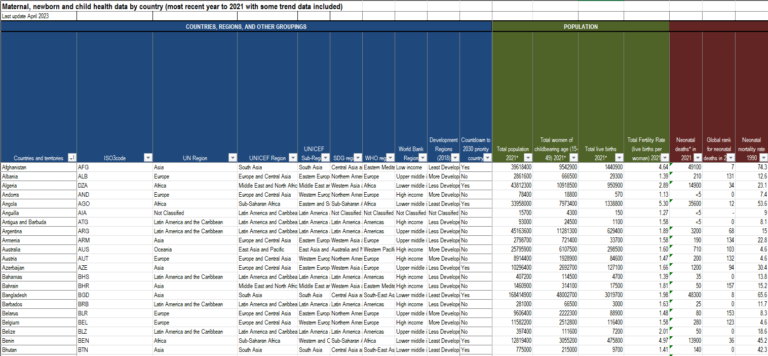It has been a dynamic year for mortality data, with the release of multiple, county-level mortality datasets in the past twelve months. However, in updating the Newborn Numbers, it is clear the data trends for maternal and newborn mortality, including stillbirths, show stagnated progress in achieving the Sustainable Development Goals (SDGs) and reducing global mortality. While the newborn mortality rate continued to trend downward, the Levels and Trends in Child Mortality 2022 report from the UN IGME shows that newborn mortality remains inequitable, with newborns in Sub-Saharan Africa facing the greatest risk of death at more than twice the global rate. When combined with Southern Asia, the two regions contain more than 80 percent of all deaths under five years of age. This high level of inequity is one of the main threats to the global success of the SDGs.
Stillbirths are not exempt from this inequity; Never Forgotten, released by UN IGME at the start of the year, shows that six countries carry almost half of the burden of stillbirths globally in 2021. This inequity continues at the national level too, with urban areas having fewer stillbirths than rural ones. There has been progress since 2000, with a reduction in global stillbirths from 21.3 per 100,000 total births to 13.9 per 100,000 total births in 2021; however, like other indicators, this progress has stagnated in recent years.
While it would seem that some of the decline in progress can be connected to the COVID-19 pandemic, data shows that maternal mortality was already stagnating before the pandemic. The newly released Trends in maternal mortality 2000 to 2020 revealed that earlier successes in reducing maternal mortality plateaued between 2016 and 2020. When looking at declines in global mortality from 2000 to 2020, it looks significant (a decrease of a third over the twenty-year period, from 339 maternal deaths per 100,000 live births to 223 in 2020); however, from 2016 to 2020 the average annual reduction in maternal mortality was negative (-.04%) indicating an increase in the maternal mortality rate globally.
This year also includes the release of the highly anticipated Lancet Series on Small Vulnerable Newborns, a landmark study years in the making. The series captures stories and data on preterm birth, small for gestational age, and babies born with low birthweight, collectively referred to as small vulnerable newborns, and highlights their unique mortality risks. In combination with Born Too Soon; decade of action on preterm birth, the Lancet series sheds light on the underreported yet far too common experience of preterm birth. The report and article series are both available online; at the time of writing the country-level datasets had not yet been released. They will be added to the Newborn Numbers once they are made public.
Data is critical for decision making at every level, from global to regional to country. The Newborn Numbers provides detailed data at each of these levels in a concise, easy to follow format, that allows for decision makers to use up-to-date data to inform policy, implement programs, and procure funding, leading to life-saving interventions to avert preventable newborn and maternal death and stillbirths. In an effort to improve accessibility, usability, and intersectionality, the HNN Team made some changes to the Newborn Numbers dataset in 2023. New indicators in maternal mortality and the health system were added, including an indicator on HIV related maternal mortality. Additionally, the mega excel was reorganized into thematic tabs for ease of use. The Chart Builder has been updated with new data, and an instructional video included to guide users through the tool. We invite users to engage with the dataset, explore the chart builder and tools, and use the information contained within to bring awareness to newborn and maternal mortality, hopefully affecting lasting, positive change.
We’re planning some changes to the Newborn Numbers feature. If you have suggestions, specifically about how you access the data, how it is presented, and possible uses for it, we’d love to hear from you! Click here to provide feedback directly to HNN.
